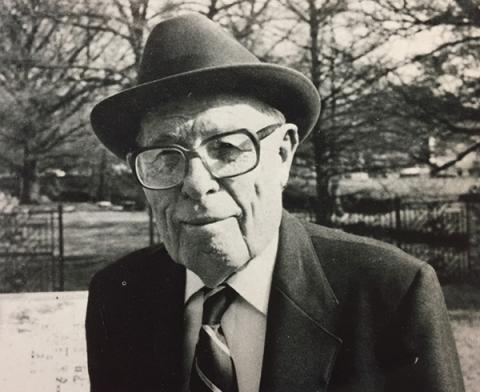
Carl J. Eckhardt Jr., for whom the university’s Heating & Power Complex (CHP) is named, is a University of Texas at Austin (UT Austin) icon.
He was the first superintendent of the UT Austin Power Plant, a Mechanical Engineering professor whose tenure at the university spanned five decades, a prominent historian who wrote six books about UT Austin, an amateur botanist who planted numerous trees along Waller Creek, and the man responsible for starting one of the greatest traditions at UT Austin – the orange lighting of the Tower.
Early life and Education
Born in October 28, 1902, to a wealthy merchant and banker in Yorktown, Texas, Eckhardt learned early on about hard labor when his family lost their wealth in 1914. That hard work carried on throughout his life, including when he arrived at The University of Texas at Austin. As a student, he worked his way through college by waiting tables in a tearoom from 1920-23, then took a year off to work as a boiler fireman in the oil fields of Luling, Texas. He returned to UT Austin as a student assistant in 1924, and obtained his bachelor’s degree in mechanical engineering in 1925. He went on to obtain his master’s degree in 1930 and became a professor in mechanical engineering in 1936.
Professional Career
As evidenced by his academic and administrative career, Carl J. Eckhardt truly enjoyed a lifetime of teaching and service. He taught mechanical engineering at the university from 1936 until his retirement in 1973, while at the same time served as superintendent of the university’s Power Plant from 1930-1937, then as superintendent of Utilities from 1937-1950, and organized and directed the Physical Plant from 1950-1970.
He also belonged to a number of professional societies such as the American Society for Engineering Education, the American Association for the Advancement of Science, and the American Society of Mechanical Engineers, where he was elected to the Fellow grade in 1955 and eventually a Life Fellow membership. He was also a registered professional engineer, with active participation in both the Texas and the National Society of Professional Engineers.
Achievements
It’s not surprising that with such a distinguished career he was honored for his many achievements. In 1973, Carl J. Eckhardt was recognized as Professor Emeritus. He was also selected as the recipient of the Presidential Citation in 1980 for his “outstanding contributions to the University and whose exemplary lives and careers have brought honor to the institution,” by then UT Austin President Peter T. Flawn. In 1984, The University of Texas System Board of Regents approved creation of the Carl J. Eckhardt Fellowship in Mechanical Engineering through the Centennial Teachers and Scholars Matching Program. Other honor societies such as Tau Beta Pi, Pi Tau Signa, Sigma Xi, and Phi Kappa Phi also recognized his outstanding achievements.
Publications
Carl J. Eckhardt was also a creative writer and authored books concerning his philosophical aspects of teaching, research, and life. Some of these books include These Things Will I Remember, Paths to an Abundant Life, Straight Furrow, Prayers to Live By, and On and On. His love for The University of Texas at Austin also led him to author six books to help preserve the history and tradition of this great university. These books include Lest I Forget the Richness of My Heritage, Fifty Stars in the University Firmament, Fifty Who Loved and Served The University of Texas at Austin, On This Hallowed Ground, Facts and Stories About Fifty Golden Years at The University of Texas, and The Directory of Outdoor Statuary.
Eckhardt also wrote extensively on engineering topics, more than 130 publications, for The American Society of Mechanical Engineers. Some of his publications can still be found at the Dolph Briscoe Center for American History. Among his many papers on file is a report, “Specifications for a complete steam generating system: Main Power Plant, University of Texas” and a publication, “Design, Installation, and Operation of an Institutional Heating Plant.”
Other University Contributions
Carl J. Eckhardt may be remembered for his contributions in engineering, but he’s also well known for having started some great traditions at The University of Texas at Austin. For instance, Eckhardt designed and supervised construction of the maces carried in commencement processions. He also devised the lighting system of the UT Austin Tower to recognize university achievements. Other significant contributions include installation of bronze plaques in each building on campus recording the building’s history and the contribution of its namesake, a catalog listing more than 75 species of trees on the university campus, and the annual Staff Service Awards Program. With Walter P. Webb, he erected the original Santa Rita oil rig on the campus. The rig, the first to “blow in” on university-owned property in West Texas, ultimately produced more than $300 million in revenues for the Permanent University Fund.
Personal Life & Death
Besides being a professor, engineer, and writer, Carl J. Eckhardt was also a man of faith. He was a member of the University Presbyterian Church and his faith transcended into his classroom lectures. Each of his engineering classes began with a prayer and ended with a “thought for the day.” Those who knew him well said that he was “a true professor from the old school,” or “very polite gentleman,” or “elegant speaker.”
Eckhardt was married to Florence Worley Kirkpatrick in 1927, and had two children, John William Eckhardt and Mary Jane Eckhardt. Florence died in 1958, and he later remarried in 1962 to Moyne Diane Treat. Eckhardt died on June 29, 1995, but left behind a legacy that will serve “as a reminder to each entering student of the achievements of those who have preceded him and as a call to rival those achievements."
To learn more about Carl J. Eckhardt read The Alcalde articles on Carl Eckhardt’s UT Mementos or his contribution of cypress trees along Waller Creek.
